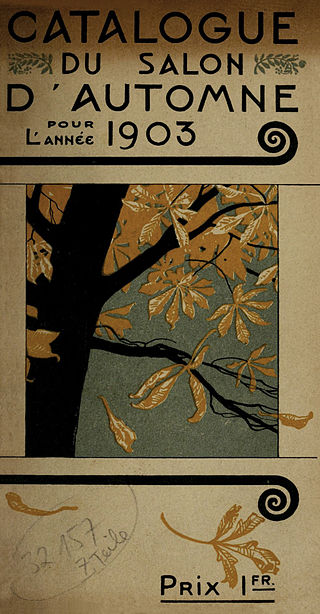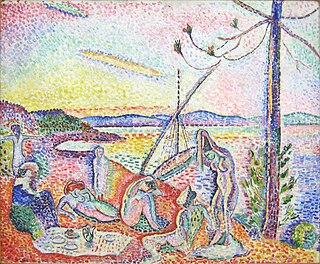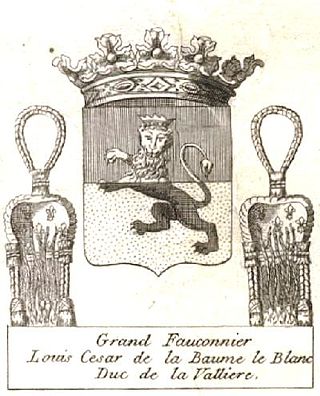Related Research Articles

Cubism is an early-20th-century avant-garde art movement begun in Paris that revolutionized painting and the visual arts, and influenced artistic innovations in music, ballet, literature, and architecture. Cubist subjects are analyzed, broken up, and reassembled in an abstract form—instead of depicting objects from a single perspective, the artist depicts the subject from multiple perspectives to represent the subject in a greater context. Cubism has been considered the most influential art movement of the 20th century. The term cubism is broadly associated with a variety of artworks produced in Paris or near Paris (Puteaux) during the 1910s and throughout the 1920s.
In cognitive linguistics and artificial intelligence, conceptual blending, also called conceptual integration or view application, is a theory of cognition developed by Gilles Fauconnier and Mark Turner. According to this theory, elements and vital relations from diverse scenarios are "blended" in a subconscious process, which is assumed to be ubiquitous to everyday thought and language. Much like memetics, it is an attempt to create a unitary account of the cultural transmission of ideas.

Passy is an area of Paris, France, located in the 16th arrondissement, on the Right Bank. It is adjacent to Auteuil to the southwest, and Chaillot to the northeast.

Gilles Fauconnier was a French linguist, researcher in cognitive science, and author, who worked in the U.S. He was distinguished professor at the University of California, San Diego, in the Department of Cognitive Science.

The Salon d'Automne, or Société du Salon d'automne, is an art exhibition held annually in Paris. Since 2011, it is held on the Champs-Élysées, between the Grand Palais and the Petit Palais, in mid-October. The first Salon d'Automne was created in 1903 by Frantz Jourdain, with Hector Guimard, George Desvallières, Eugène Carrière, Félix Vallotton, Édouard Vuillard, Eugène Chigot and Maison Jansen.

The Société des Artistes Indépendants or Salon des Indépendants was formed in Paris on 29 July 1884. The association began with the organization of massive exhibitions in Paris, choosing the slogan "sans jury ni récompense". Albert Dubois-Pillet, Odilon Redon, Georges Seurat and Paul Signac were among its founders. For the following three decades their annual exhibitions set the trends in art of the early 20th century, along with the Salon d'Automne. This is where artworks were often first displayed and widely discussed. World War I brought a closure to the salon, though the Artistes Indépendants remained active. Since 1920, the headquarters has been located in the vast basements of the Grand Palais.

Louis Vauxcelles was a French art critic. He is credited with coining the terms Fauvism (1905) and Cubism (1908). He used several pseudonyms in various publications: Pinturrichio, Vasari, Coriolès, and Critias.

André Dunoyer de Segonzac was a French painter and graphic artist.

Belgium competed at the 1948 Summer Olympics in London, England. 152 competitors, 132 men and 20 women, took part in 77 events in 17 sports.

The Grand Falconer of France was a position in the King's Household in France from the Middle Ages to the French Revolution.

Henri Victor Gabriel Le Fauconnier was a French Cubist painter born in Hesdin. Le Fauconnier was seen as one of the leading figures among the Montparnasse Cubists. At the 1911 Salon des Indépendants Le Fauconnier and colleagues Jean Metzinger, Albert Gleizes, Fernand Léger and Robert Delaunay caused a scandal with their Cubist paintings. He was in contacts with many European avant-garde artists such as Wassily Kandinsky, writing a theoretical text for the catalogue of the Neue Künstlervereinigung in Munich, of which he became a member. His paintings were exhibited in Moscow reproduced as examples of the latest art in Der Blaue Reiter Almanach.

Henri Fauconnier was a French writer, known mainly for his novel Malaisie, which won the Prix Goncourt in 1930. He was part of the Groupe de Barbezieux.

Geneviève Fauconnier was a French novelist who lived in the south of the Charente département (France). She was one of the most sensitive members of the so-called Groupe de Barbezieux. Her brother, Henri Fauconnier and Jacques Chardonne were some of the most famous writers of this group.

Proto-Cubism is an intermediary transition phase in the history of art chronologically extending from 1906 to 1910. Evidence suggests that the production of proto-Cubist paintings resulted from a wide-ranging series of experiments, circumstances, influences and conditions, rather than from one isolated static event, trajectory, artist or discourse. With its roots stemming from at least the late 19th century, this period is characterized by a move towards the radical geometrization of form and a reduction or limitation of the color palette. It is essentially the first experimental and exploratory phase of an art movement that would become altogether more extreme, known from the spring of 1911 as Cubism.

Académie de La Palette, also called Académie La Palette and La Palette,, was a private art school in Paris, France, active between 1888 and 1925, aimed at promoting 'conciliation entre la liberté et le respect de la tradition'.

Woman with Phlox is an oil painting created in 1910 by the French artist Albert Gleizes. The painting was exhibited in Room 41 at the Salon des Indépendants in the Spring of 1911 ; the exhibition that introduced Cubism as a group manifestation to the general public for the first time. The complex collection of geometric masses in restrained colors exhibited in Room 41 created a scandal from which Cubism spread throughout Paris, France, Europe and the rest of the world. It was from the preview of the works by Gleizes, Jean Metzinger, Henri Le Fauconnier, Robert Delaunay, and Fernand Léger at the 1911 Indépendants that the term 'Cubism' can be dated. La Femme aux Phlox was again exhibited the following year at the Salon de la Section d'Or, Galerie La Boétie, 1912. La Femme aux Phlox was reproduced in The Cubist Painters, Aesthetic Meditations by Guillaume Apollinaire, published in 1913. The same year, the painting was again revealed to the general public, this time in the United States, at the International Exhibition of Modern Art, New York, Chicago, and Boston. The work is now in the Museum of Fine Arts, Houston, Gift of the Esther Florence Whinery Goodrich Foundation in 1965.
The Groupe de Barbezieux were French writers from three Charentais families, Fauconnier, Boutelleau and Delamain, who were childhood friends in the town of Barbezieux, in the Charente département, France. Although the école de Barbezieux is often mentioned, they did not necessarily share the same outlook.

The Fauconnier Patent was a royal land patent granted in 1705 in Dutchess County, Province of New York. It was the twelfth of fourteen granted between 1685 and 1706 that came to comprise the entirety of the historic county footprint.

The Banks of the Marne is a proto-Cubist oil painting on canvas created in 1909 by the French artist Albert Gleizes. In this work can be seen a departure from the representation of the observable world. The development of Cubist and abstract art in the work of Gleizes was necessarily a transformation from the synthetic preoccupation with his subject matter. The passage of Gleizes' painting from an epic visionary figuration to total abstraction was foreshadowed during his proto-Cubist period. Bords de la Marne measures 54 × 65 cm, and is currently in the permanent collection of the Musée des Beaux-Arts de Lyon.
References
- ↑ "Louis Fauconnier Olympic Results". sports-reference.com. Archived from the original on 18 April 2020. Retrieved 13 July 2012.